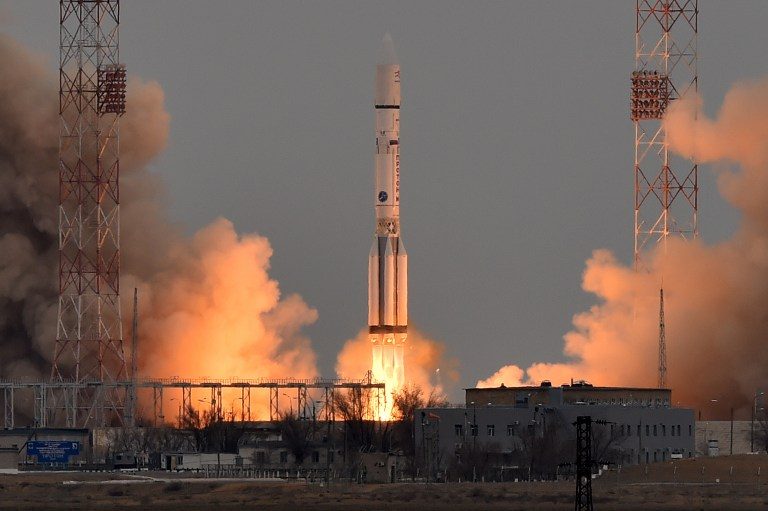SUMMARY
This is AI generated summarization, which may have errors. For context, always refer to the full article.

BAIKONUR, Kazakhstan – Two robotic spacecraft on Monday, March 14, began a 7-month journey to Mars as part of a European-Russian unmanned space mission to sniff out leads to life on the Red Planet.
Russia’s Proton rocket carrying the spacecraft launched into an overcast sky at the Russian-operated Baikonur cosmodrome in the Kazakh steppe at 0931 GMT according to plan, the Russian space agency Roscosmos and the European Space Agency (ESA) said.
Roscosmos said the launch had taken place “successfully.”
ExoMars 2016, a collaboration between ESA and Roscosmos, is the first part of a two-phase exploration aiming to answer questions about the existence of life on Mars.
The ESA has said the aim was to determine “whether Mars is ‘alive.'”
With its suite of high-tech instruments, the Trace Gas Orbiter (TGO), is expected to arrive at the Red Planet in October after a journey of 496 million kilometers (308 million miles).
TGO will photograph the Red Planet and analyze its air, splitting off from the Mars lander dubbed Schiaparelli days before entering its atmosphere.
The second phase, a Mars rover due for launch in 2018, seems likely to be delayed over financial concerns.
One key goal is to analyze methane, a gas which on Earth is created in large part by living microbes, and traces of which were observed by previous Mars missions.
‘Nose in space’
“TGO will be like a big nose in space,” said Jorge Vago, ExoMars project scientist.
Methane, the ESA said, is normally destroyed by ultraviolet radiation within a few hundred years, which implied that in Mars’ case “it must still be produced today.”
TGO will analyze Mars’ methane in more detail than any previous mission, said ESA, in order to try to determine its likely origin.
One component of TGO, a neuron detector called FREND, can help provide improved mapping of water distribution on Mars, amid growing evidence the planet once had as much if more water than earth.
A better understanding of water on Mars, the fourth planet from the sun, could aid scientists’ understanding of how the Earth might cope in conditions of increased drought.
Schiaparelli, in turn, will spend several days measuring climatic conditions including seasonal dust storms on the Red Planet while serving as a test lander ahead of the rover’s anticipated arrival.
The module takes its name from 19th century Italian astronomer Giovanni Schiaparelli whose discovery of “canals” on Mars caused people to believe, for a while, that there was intelligent life on our neighboring planet.
‘Need more money’
As for the next phase of ExoMars, ESA director general Jan Woerner has mooted a possible two-year delay, saying in January: “We need some more money” due to cost increases.
The rover scheduled for 2018 has been designed to drill up to two meters (around 7 feet) into the Red Planet in search of organic matter, a key indicator of life past or present.
ESA said the rover landing “remains a significant challenge” however.
Although TGO’s main science mission is scheduled to last until December 2017, it has enough fuel to continue operations for years after, if all goes well.
Thomas Reiter, director of human spaceflight at ESA, said in televised remarks ahead of the launch he believed a manned mission to Mars would take place “maybe in 20 years or 30 years.”
Russian-American duo Mikhail Kornienko and Scott Kelly earlier this month returned from a year-long mission at the International Space Station seen as a vital precursor to such a mission.
The ExoMars mission derives its name from the scientific term for the search for life beyond Earth – exobiology.
Space has been one of the few areas of cooperation between Moscow and the West that has not been damaged by ongoing geopolitical tensions stemming from to the crises in Ukraine and Syria. – Kirill Kudryavtsev, AFP / Rappler.com
Add a comment
How does this make you feel?
There are no comments yet. Add your comment to start the conversation.